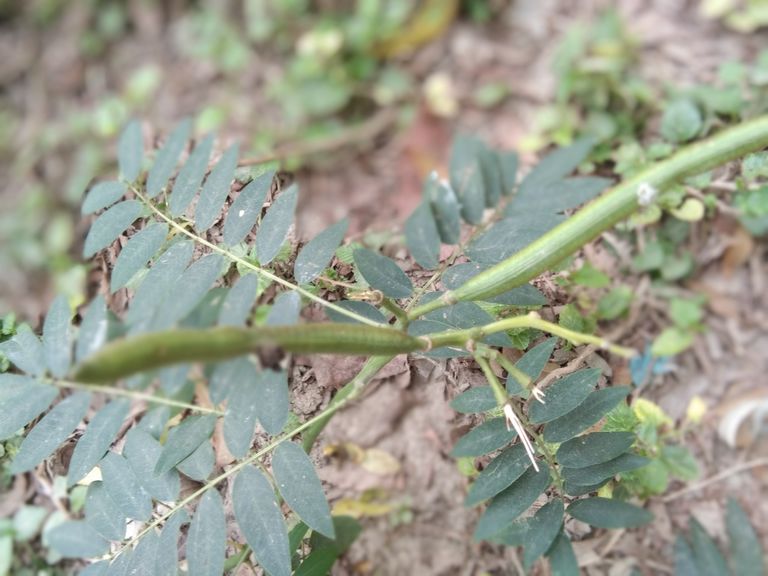Assalamu alaikum ❤️. This is me Sumaya afrin supti. My blurt name @sumayasupti
Here I will describe the different types of plants, These plants are all around us and I must tell you about the benefits of many beneficial plants. Here the first picture of plant name is mexican prickly poppy. This scientific name is argemone maxicana.
The Mexican prickly poppy, scientifically known as Argemone mexicana, is a fascinating plant with a rich history and diverse range of uses. Native to Mexico, this perennial herbaceous plant belongs to the Papaveraceae family and is characterized by its striking yellow or white flowers and spiky, thistle-like leaves.
One of the most intriguing aspects of the Mexican prickly poppy is its historical significance. Indigenous communities in Mexico have long recognized the medicinal properties of this plant. Traditional medicine has employed various parts of the plant, including the roots, leaves, and seeds, to treat a variety of ailments. The latex extracted from the stem has been used topically to alleviate skin conditions, while the seeds are believed to possess analgesic and anti-inflammatory properties.
In addition to its medicinal uses, the Mexican prickly poppy has found applications in various cultural and religious practices. Some indigenous communities incorporate the plant into rituals and ceremonies, considering it sacred and symbolic. Its presence in traditional folklore adds another layer of cultural importance to this distinctive plant.
The striking appearance of the Mexican prickly poppy makes it a noteworthy botanical specimen. The bright, saucer-shaped flowers with yellow or white petals stand out against the spiny leaves, creating a visually arresting contrast. The plant's adaptability to different climates has led to its spread beyond Mexico, making it a recognizable presence in various regions around the world.
The ecological role of the Mexican prickly poppy is noteworthy as well. As a hardy plant, it can thrive in diverse environments, including arid regions where many other plants struggle to survive. This resilience contributes to soil stabilization and erosion control, making the Mexican prickly poppy a valuable asset in ecosystems facing environmental challenges.
However, it's crucial to note that while the Mexican prickly poppy has positive attributes, it can also pose challenges in certain contexts. Considered invasive in some areas, the plant's ability to spread rapidly can lead to competition with native flora. As with many introduced species, careful management is essential to mitigate potential negative impacts on local ecosystems.
The Mexican prickly poppy's scientific significance extends to its chemical composition. Researchers have identified alkaloids and other compounds in various parts of the plant, contributing to ongoing studies on its pharmacological properties. These investigations aim to unlock the full potential of the plant for medical and therapeutic applications while understanding any potential risks associated with its use.
In conclusion, the Mexican prickly poppy stands as a multifaceted botanical wonder with deep cultural roots, ecological significance, and promising medicinal properties. Its journey from traditional medicine to contemporary scientific research reflects the ongoing exploration of nature's treasures and the delicate balance between utilizing and conserving our planet's diverse plant life.
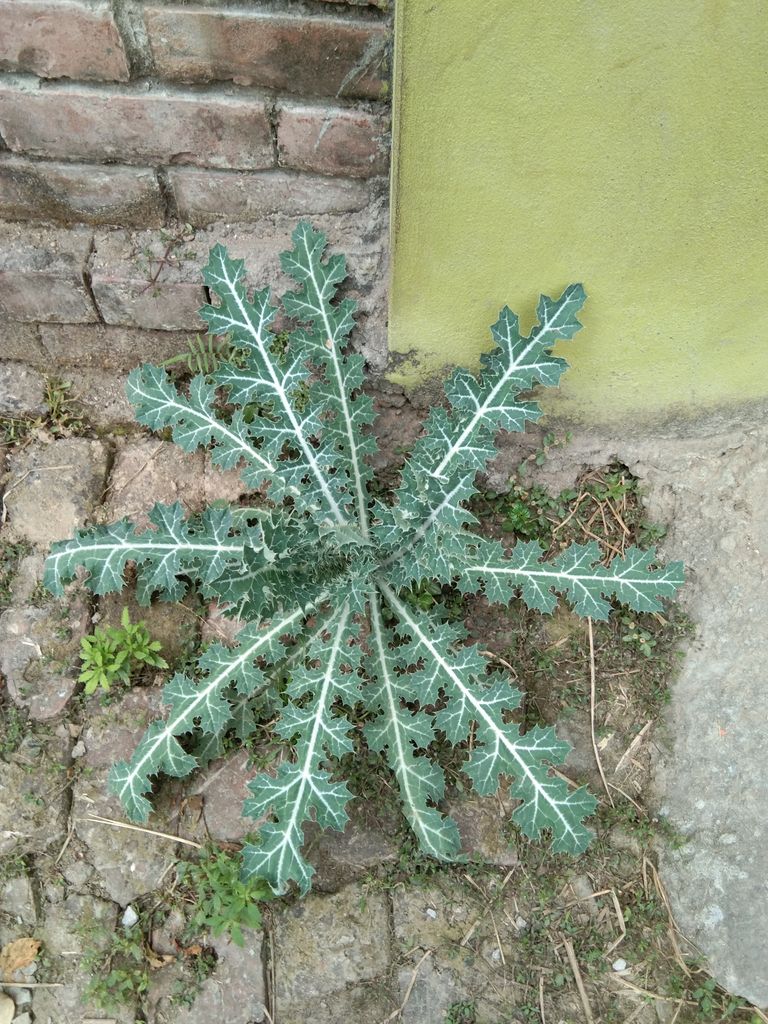
Pros of Mexican Prickly Poppy Plant:
Medicinal Uses: The plant has been traditionally used in Mexican folk medicine for its potential analgesic and sedative properties.
Ornamental Value: Mexican prickly poppy is cultivated for its attractive flowers, making it a visually appealing addition to gardens.
Adaptability: It can thrive in various soil types and is relatively resilient, making it suitable for diverse environmental conditions.
Wildlife Attraction: The flowers attract pollinators like bees and butterflies, contributing to ecosystem biodiversity.
Cons of Mexican Prickly Poppy Plant:
Invasive Potential: In some regions, the plant can become invasive, outcompeting native vegetation and disrupting ecosystems.
Toxicity: The plant contains alkaloids that can be toxic if ingested, posing a risk to livestock and potentially causing harm if not handled properly.
Aggressiveness: Mexican prickly poppy can be aggressive in its growth habits, spreading rapidly and potentially crowding out other plants in a garden or natural habitat.
Legal Restrictions: In certain areas, the plant may be considered a noxious weed, leading to legal restrictions on its cultivation and propagation
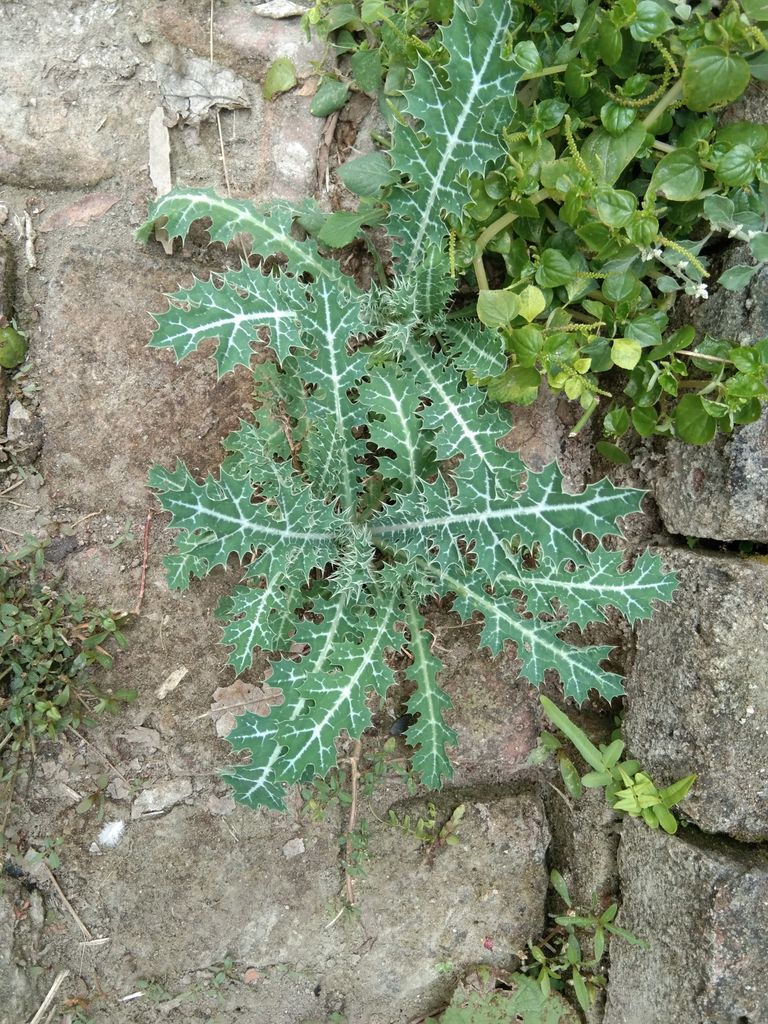
Here are another plant name is Honey Locust tree.
The Honey Locust tree, scientifically known as Gleditsia triacanthos, is a deciduous tree that belongs to the Fabaceae family. Native to North America, this tree is renowned for its unique features, including distinctive compound leaves and long, branched thorns.
One of the most striking aspects of the Honey Locust tree is its pinnately compound leaves, which typically consist of numerous small leaflets arranged along a central stem. The leaflets are bright green and provide an elegant, airy appearance to the tree's foliage. During the fall, these leaves transition to a vibrant yellow hue before gracefully falling, creating a picturesque autumn landscape.
The tree is recognized not only for its foliage but also for the impressive thorns that adorn its branches. These thorns can grow up to several inches in length and are clustered along the branches, serving as a form of defense against browsing animals. Despite their imposing appearance, these thorns are generally not harmful to touch and contribute to the Honey Locust's distinctive silhouette.
In addition to its ornamental value, the Honey Locust tree produces intriguing fruits. The tree bears long, twisted, and pod-like fruits, which often reach lengths of up to 18 inches. These pods mature during the late summer and fall, adding an extra layer of visual interest to the tree. As the pods ripen, they turn from green to a dark brown, contributing to the overall aesthetic appeal of the tree.
Moreover, the seeds within the pods are surrounded by a sweet, sticky pulp, giving the tree its common name, "Honey Locust." This sugary substance attracts various wildlife, including birds and mammals, which play a role in seed dispersal. The tree's ability to thrive in a range of soil types and climates makes it a resilient and adaptable species.
Landscapers often appreciate the Honey Locust for its ability to provide light, dappled shade due to its open canopy. This makes it a popular choice for urban and suburban environments, where its aesthetic qualities and adaptability shine. Additionally, its tolerance to pollution further enhances its suitability for these settings.
In conclusion, the Honey Locust tree stands out not only for its attractive foliage and formidable thorns but also for its distinctive fruits. Its adaptability, resilience, and aesthetic appeal make it a valuable addition to diverse landscapes, offering both visual interest and ecological significance.
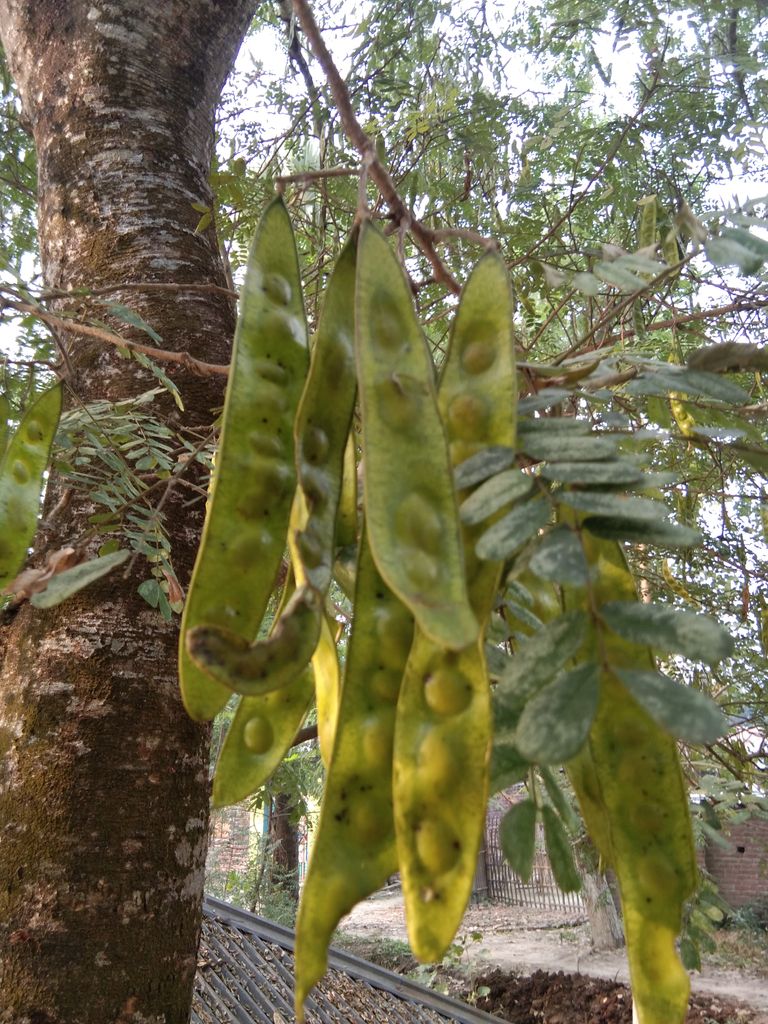
Here are the pons and cons of honey locust tree.
The honey locust tree (Gleditsia triacanthos) is a deciduous tree known for its distinctive compound leaves and long, branched thorns. The tree produces pod-like fruits that have both benefits and potential harms.
Benefits:
Ornamental Value: Honey locust trees are often planted for their ornamental beauty. Their delicate, fern-like foliage provides shade and creates an aesthetically pleasing landscape.
Nitrogen Fixation: The honey locust has a symbiotic relationship with nitrogen-fixing bacteria in its root nodules. This helps improve soil fertility by converting atmospheric nitrogen into a form that plants can use.
Wildlife Habitat: The tree's pods serve as a food source for various wildlife, including deer, squirrels, and birds. This makes honey locusts valuable for promoting biodiversity in natural ecosystems.
Durable Wood: The wood of the honey locust is strong and durable, making it suitable for various purposes. It has been historically used for fence posts, furniture, and in some cases, as timber.
Tolerance to Harsh Conditions: Honey locusts are relatively hardy and can tolerate a range of soil types, including compacted and poor soils. They are also resistant to some diseases and pests.
Harms:
Thorns: One of the notable drawbacks of honey locust trees is the presence of sharp thorns. While some varieties are thornless, others have formidable thorns that can pose a hazard, especially in areas where people walk barefoot.
Invasive Roots: The roots of honey locust trees can be invasive and may cause damage to sidewalks, driveways, and underground utilities. Careful consideration of planting location is necessary to avoid potential issues.
Pod Litter: The tree produces long, twisted pods that can create a significant amount of litter, particularly in urban areas. This may necessitate regular cleanup to maintain a tidy environment.
Allergies: Some people may be allergic to the pollen produced by honey locust trees. This can cause respiratory issues and discomfort, especially during the tree's flowering season.
Limited Edible Use: While the pulp inside the pods is edible, it is not widely consumed due to its unpalatable taste. Additionally, the seeds within the pods are toxic if ingested.
In conclusion, honey locust trees offer several benefits, including ornamental value, wildlife support, and nitrogen fixation. However, potential harms such as thorns, invasive roots, and pod litter should be considered when planting them in specific locations. Careful planning and maintenance can help maximize the positive aspects of honey locust trees while minimizing the potential drawbacks.
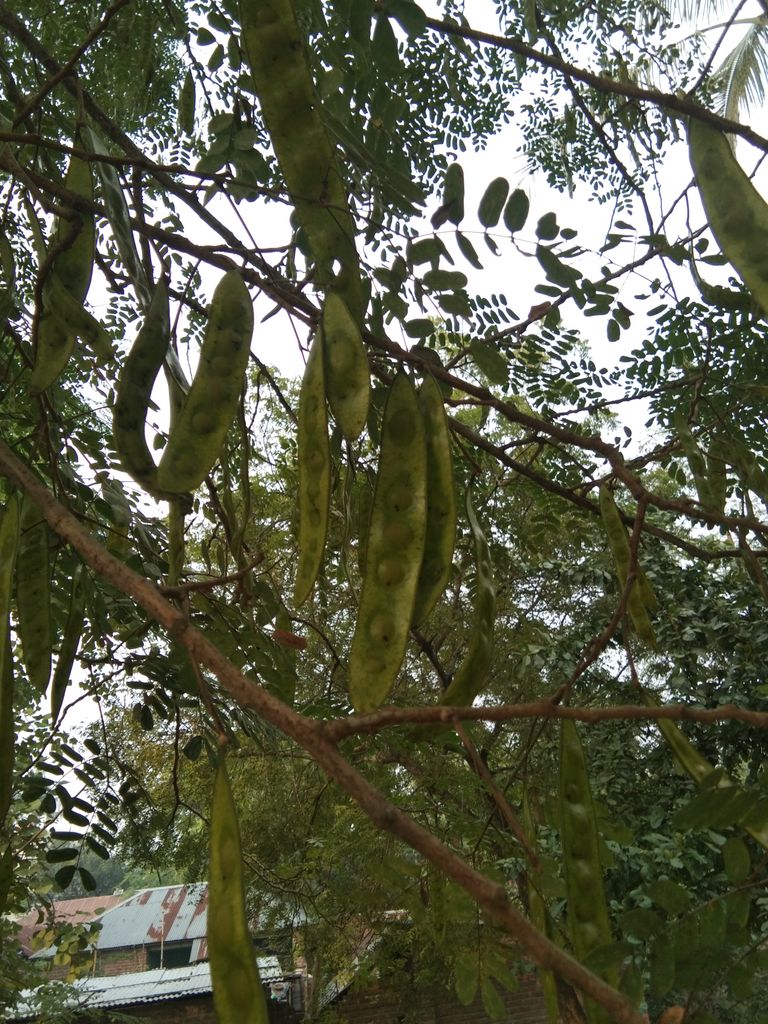
Here are the another plant name is calabash tree.
The Calabash tree, scientifically known as Crescentia cujete, is a fascinating and culturally significant species found in tropical regions around the world. Known for its distinctive gourd-like fruits and large, spreading canopy, the Calabash tree holds a unique place in both ecological and human contexts.
One of the most distinctive features of the Calabash tree is its fruit, which resembles a large, spherical or oval-shaped gourd. These fruits, often referred to as calabashes, have a hard, woody shell and a fleshy interior. Traditionally, these gourds have been used for various purposes by different cultures. They can be hollowed out to create containers for holding liquids, serving as natural bowls, or even fashioned into musical instruments. The versatility of the calabash has led to its integration into daily life in many tropical regions.
Ecologically, the Calabash tree plays a crucial role in its native habitats. As a deciduous tree, it sheds its leaves during the dry season, contributing organic matter to the soil and supporting nutrient cycling. The large, umbrella-like canopy provides shade for other plants and animals, creating a microhabitat that fosters biodiversity. Additionally, the flowers of the Calabash tree attract pollinators, such as bees and butterflies, contributing to the overall health of the ecosystem.
Culturally, the Calabash tree has deep roots in folklore and traditional practices. In various societies, the tree is associated with symbolism and spiritual significance. Its unique appearance and utility have made it a symbol of abundance, fertility, and resilience in many cultures. The traditional uses of calabashes as containers and instruments are often intertwined with rituals, ceremonies, and daily life.
Furthermore, the Calabash tree has made its mark in art and literature. Its distinctive shape and cultural associations have inspired artists and writers across generations. Its inclusion in indigenous stories and myths adds to the rich tapestry of cultural narratives, highlighting the interconnectedness between nature and human societies.
Despite its cultural significance, the Calabash tree faces threats due to habitat loss, deforestation, and changing climatic conditions. Conservation efforts are crucial to preserving this iconic species and maintaining the biodiversity it supports. Educational initiatives about the ecological importance and cultural value of the Calabash tree can contribute to sustainable practices and promote its conservation.
In conclusion, the Calabash tree stands as a remarkable example of the intricate relationship between nature and culture. Its unique features, ecological role, and cultural significance make it a symbol of resilience and interconnectedness. As we strive to preserve our natural heritage, understanding and appreciating the multifaceted contributions of species like the Calabash tree become essential for a sustainable future.
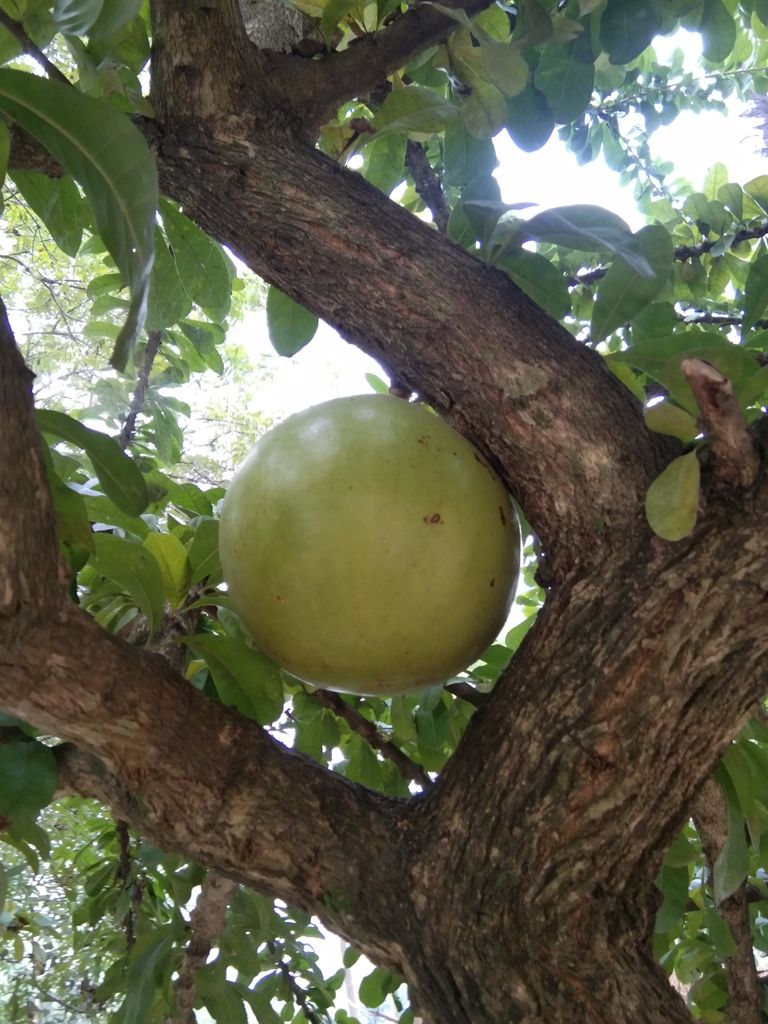
Here are the benefits and harm of calabash trethe
The calabash tree, scientifically known as Crescentia cujete, is a unique and versatile plant that has been recognized for its various benefits and potential harms. Native to Central and South America, the tree has spread to other tropical regions worldwide. Here, we explore the positive aspects as well as the potential drawbacks associated with the calabash tree.
Benefits:
Cultural Significance: The calabash tree holds cultural significance in many societies. Its large, round fruits have been used traditionally as containers, bowls, and musical instruments. In some cultures, these gourds are intricately carved and decorated, serving both functional and aesthetic purposes.
Medicinal Uses: Different parts of the calabash tree, such as the leaves, fruit, and bark, have been utilized in traditional medicine. Extracts from these parts are believed to possess antimicrobial and anti-inflammatory properties. They have been employed to treat conditions such as wounds, skin infections, and respiratory issues.
Ecological Role: Calabash trees play a role in the ecosystem by providing shade and shelter for various animals. Birds are known to nest in the branches, and the large fruits attract wildlife, contributing to biodiversity in the surrounding environment.
Soil Erosion Prevention: The extensive root system of the calabash tree aids in preventing soil erosion. This is particularly valuable in tropical regions where heavy rainfall can lead to soil degradation.
Ornamental Value: The calabash tree is often cultivated for its ornamental value. Its attractive, broad canopy and distinctive, bottle-shaped fruits make it a popular choice for landscaping in tropical gardens.
Potential Harms:
Invasive Nature: In some non-native regions, the calabash tree has become invasive, outcompeting local flora. This can have negative impacts on the native ecosystem, affecting the balance of plant and animal species.
Allergenic Potential: While the calabash tree is not generally considered highly allergenic, some individuals may develop skin irritations upon contact with its sap or other plant parts. Sensitivity varies from person to person.
Inedible Fruit: Despite its cultural and decorative uses, the calabash fruit is generally not consumed as it may be toxic. The pulp can be bitter and contain substances that are harmful if ingested.
Limited Commercial Use: Despite its versatility, the calabash tree has limited commercial applications. The irregular shape and size of its fruits, along with the time required for them to mature, make it less suitable for large-scale agricultural purposes compared to other crops.
Vulnerability to Pests: Like many plants, the calabash tree is susceptible to various pests and diseases. This vulnerability can affect its overall health and may necessitate the use of pesticides, which could have negative environmental consequences.
In conclusion, the calabash tree possesses a range of cultural, ecological, and medicinal benefits. However, its invasive potential, limited commercial use, and the presence of potential allergens highlight the importance of careful consideration and management when introducing or cultivating this species. As with any natural resource, a balanced approach is essential to maximize the positive aspects while minimizing potential harms.
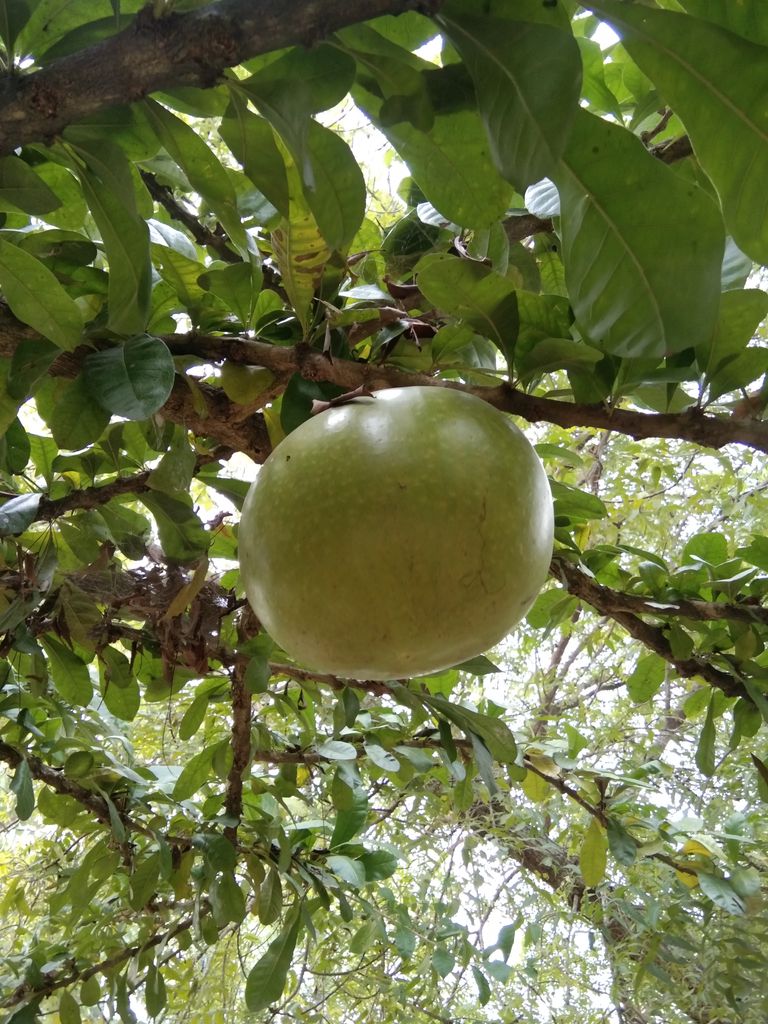

Here are the cucumis plant.
Cucumis is a genus of flowering plants belonging to the gourd family, Cucurbitaceae. This diverse genus encompasses various species, but one of the most well-known members is Cucumis sativus, commonly known as the cucumber. Cucumbers are cultivated worldwide for their crisp texture, mild flavor, and versatility in culinary applications.
The cucumber plant is a sprawling vine that typically features lobed leaves and produces cylindrical fruits. Its cultivation dates back thousands of years, with origins believed to trace to South Asia. Over time, cucumbers have become a staple in many cuisines, appreciated for their refreshing taste and high water content.
One distinctive feature of cucumbers is their composition, which is largely water. This makes them a low-calorie food and a hydrating snack. Additionally, cucumbers provide essential vitamins and minerals, including vitamin K, vitamin C, potassium, and manganese. These nutritional elements contribute to the overall health benefits associated with consuming cucumbers.
The cultivation of cucumbers involves selecting suitable varieties and providing well-drained soil, ample sunlight, and adequate water. While some cucumber varieties are intended for slicing and consumption in salads, others are cultivated for pickling. Pickling cucumbers are generally smaller and possess a firm texture, making them ideal for preserving in vinegar and brine.
Beyond their culinary uses, cucumbers have found applications in skincare. Due to their high water content and soothing properties, cucumber slices are often used to reduce puffiness around the eyes. Furthermore, cucumber extracts are incorporated into cosmetic products for their hydrating and refreshing effects on the skin.
The life cycle of a cucumber plant involves germination from seeds, followed by the growth of seedlings. As the vine matures, it develops tendrils that aid in climbing and anchoring. The plant produces yellow flowers, and the fertilized female flowers develop into the familiar elongated fruits. Cucumbers can be harvested at various stages of maturity, with younger ones being more tender and suitable for fresh consumption.
Cucumbers are susceptible to certain pests and diseases, including aphids, cucumber beetles, and powdery mildew. Integrated pest management strategies, such as companion planting and the use of natural predators, are employed to mitigate these issues and promote healthy crop growth.
In addition to Cucumis sativus, other notable species in the Cucumis genus include Cucumis melo (melons) and Cucumis anguria (West Indian gherkin). Each species within the genus exhibits unique characteristics and adaptations to different climates and growing conditions.
In conclusion, the Cucumis plant, particularly Cucumis sativus, plays a significant role in agriculture and culinary practices worldwide. From its origins in South Asia to its integration into various global cuisines, the cucumber has become a versatile and valued vegetable. Whether enjoyed fresh in salads, pickled for preservation, or utilized in skincare routines, the cucumber continues to be a staple in households
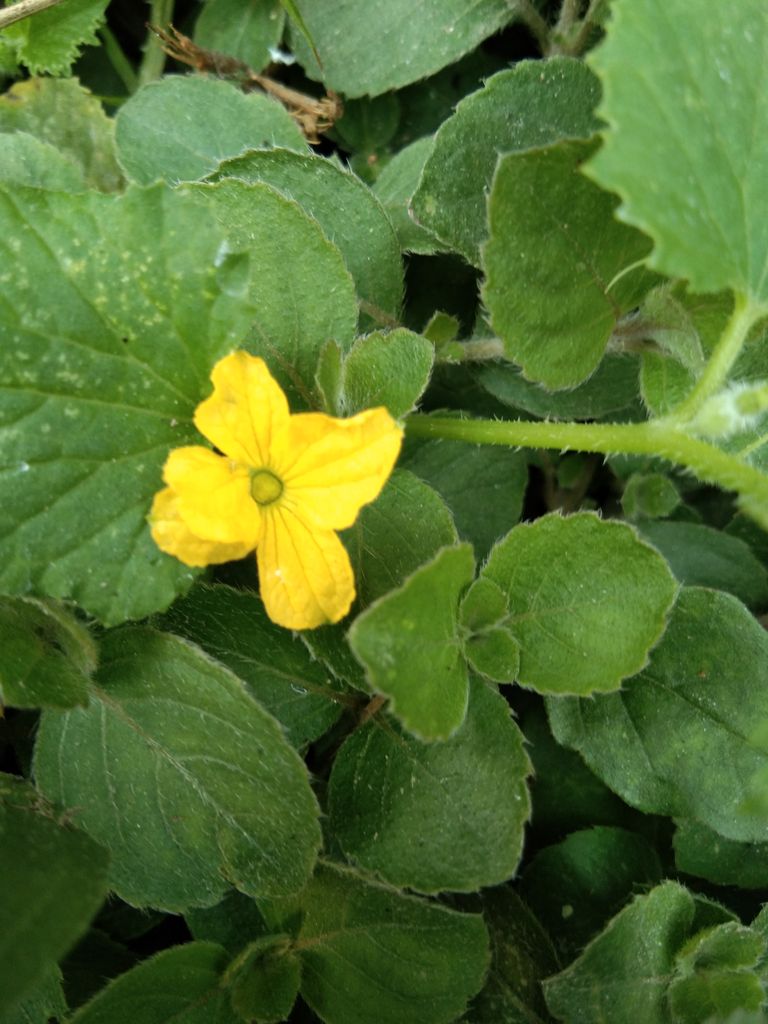
Senna corymbosa, also known as the Spanish flag or buttercup bush, is a flowering plant native to South America. It's prized for its vibrant yellow flowers and is commonly grown as an ornamental shrub in gardens. Additionally, some species within the Senna genus are used in traditional medicine for their laxative properties.
Description:
Senna corymbosa typically reaches a height of 6 to 10 feet (1.8 to 3 meters) and spreads out with a similar width. Its dark green, pinnately compound leaves are complemented by clusters of bright yellow flowers, creating a visually appealing contrast. The flowers, which resemble small butterflies, bloom in abundance during the warm seasons, attracting pollinators like bees and butterflies.
Cultural Significance:
Aside from its ornamental value, Senna corymbosa holds cultural significance in traditional medicine. Some communities have utilized parts of the plant for their potential laxative properties. However, caution is advised as certain compounds in the plant may have purgative effects.
Growing Conditions:
One of the key reasons for the popularity of Senna corymbosa in gardens is its adaptability. It thrives in a variety of soil types, from well-draining sandy soils to loamy or clayey compositions. The plant prefers full sun exposure but can tolerate partial shade. Adequate watering is essential during the establishment phase, but once mature, the Argentine senna is relatively drought-tolerant.
Propagation:
Propagating Senna corymbosa can be achieved through seeds or cuttings. Seeds should be planted in well-prepared soil during the spring, while cuttings can be taken from semi-hardwood in late spring or early summer. Regular pruning is recommended to maintain a compact shape and encourage prolific flowering.
Landscaping Uses:
Gardeners often include Senna corymbosa for its aesthetic appeal and ability to attract butterflies, hence the common name "butterfly bush." Its upright and bushy growth habit makes it suitable for hedges, borders, or as a standalone specimen. In addition to its visual appeal, the plant's ability to attract pollinators contributes to the overall biodiversity of the garden.
Maintenance:
Caring for Senna corymbosa is generally straightforward. Regular pruning not only helps maintain its shape but also encourages the development of new flowering branches. While the plant is relatively low-maintenance, it is important to monitor for any signs of pests or diseases, addressing issues promptly to ensure the plant's health.
Environmental Impact:
As an introduced species in various regions, Senna corymbosa has raised concerns about its potential invasiveness. In some areas, it may self-seed and spread rapidly, outcompeting native vegetation. Therefore, careful consideration should be given to its cultivation, especially in regions where it is not native.
In conclusion, Senna corymbosa stands out as an attractive and versatile plant with ornamental, medicinal, and ecological significance. Whether adorning gardens with its vibrant blooms or serving traditional purposes in certain cultures, this South American native has made a notable mark in the world of horticulture. As with any introduced species, responsible cultivation and management are crucial to mitigate potential environmental impact.
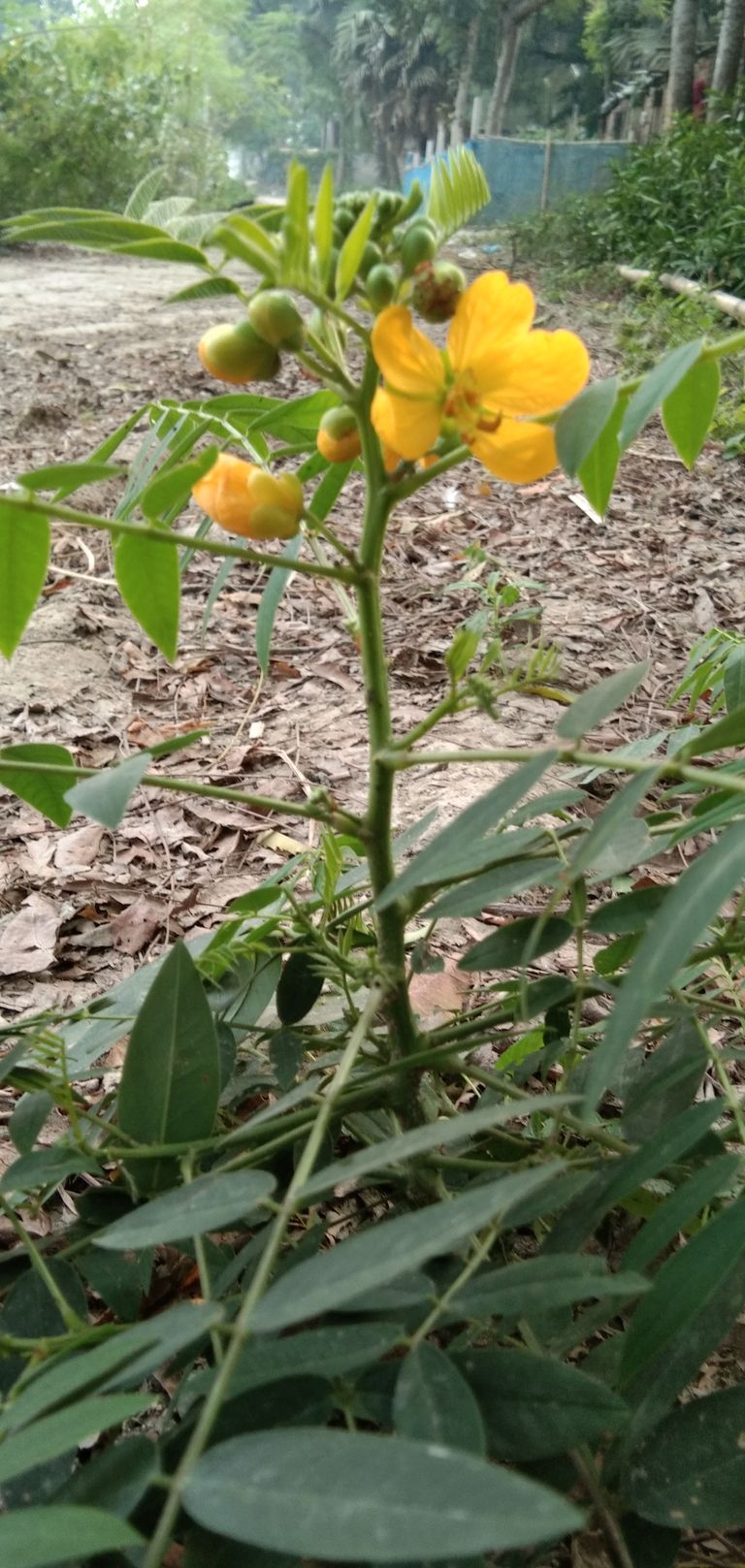
Senna corymbosa: Benefits and Harms
Senna corymbosa, commonly known as the crownsenna or butterfly cassia, is a flowering plant with a rich history of traditional medicinal use. While it offers certain benefits, it is crucial to be aware of potential harms associated with its usage.
Benefits:
Laxative Properties:
Senna corymbosa is renowned for its potent laxative effects. It contains compounds such as anthraquinones that stimulate bowel movements, making it valuable for relieving constipation.
Digestive Health:
The laxative action aids in promoting regular bowel movements, potentially alleviating discomfort associated with constipation and supporting overall digestive health.
Traditional Medicine:
In traditional medicine, Senna corymbosa has been used to address various gastrointestinal issues, including indigestion and bloating.
Anti-inflammatory Potential:
Some studies suggest that certain compounds in Senna corymbosa may possess anti-inflammatory properties. This could have implications for managing inflammation-related conditions, although more research is needed.
Antioxidant Effects:
Antioxidants present in the plant may help combat oxidative stress, potentially contributing to cellular health and reducing the risk of chronic diseases.
Harms:
Dehydration:
Prolonged or excessive use of Senna corymbosa as a laxative may lead to dehydration due to increased water loss through frequent bowel movements.
Electrolyte Imbalance:
The laxative effect can result in the loss of essential electrolytes, such as potassium, which is critical for proper muscle and heart function. Electrolyte imbalance can have adverse effects on health.
Dependency and Tolerance:
Regular use of Senna corymbosa as a laxative may lead to dependency, where the body becomes reliant on it for regular bowel movements. Additionally, there is a risk of developing tolerance, requiring higher doses over time to achieve the same laxative effect.
Abdominal Cramps:
Some individuals may experience abdominal cramps or discomfort as a side effect of using Senna corymbosa, particularly if consumed in excess.
Not Suitable for Everyone:
Pregnant or breastfeeding women, individuals with certain medical conditions (such as gastrointestinal disorders), and those taking specific medications should avoid or use Senna corymbosa under medical supervision.
Conclusion:
While Senna corymbosa offers benefits, its use requires caution. It is essential to consult with healthcare professionals before incorporating it into your health regimen, especially considering the potential harms associated with its laxative properties. Moderation is key, and individuals should be mindful of their overall health status and medical history when considering the use of Senna corymbosa.
